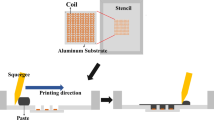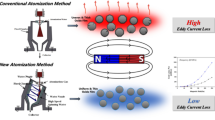Abstract
A molding coil is molded directly onto enameled wire using soft magnetic materials. When the molding coil size becomes smaller and thinner, the granules consisting of magnetic powder and organic binder cannot evenly fill the coil center column during molding, thereby causing cracks or deterioration in the products. In this study, FeSiCr alloy powder coils were prepared using gel casting. The structures and magnetic properties of coils prepared by dry pressing and gel casting were compared. The experimental results showed that the low-viscosity slurry used in the gel casting process can significantly improve the powder filling uniformity in the coil center. Gel casting protects the enameled wire from being damaged and short-circuited. FeSiCr alloy powder coils prepared using the gel casting process have higher inductance and better DC-bias superposition characteristics than those prepared using dry pressing. However, if the slurry viscosity for gel casting is too high, the powder packing in the coil center column becomes worse, which leads to a lower inductance value. The binder content in gel casting is also lower than that in dry pressing, resulting in a higher initial permeability with the same or higher mechanical strength as that prepared by dry pressing due to the more homogeneous binder distribution. For small-sized and high-inductance FeSiCr alloy powder coils, the problems of uneven packing and cracks in the coil center column can be effectively solved using the gel casting process.










Similar content being viewed by others
References
H.I. Hsiang, J. Mater. Sci.: Mater. Electron. 31, 16089–16110 (2020)
H.I. Hsiang, L.F. Fan, K.T. Ho, IEEE Trans. Magn. 54, 2000407 (2018)
Y.P. Wu, H.Y. Chiang, H.I. Hsiang, AIP Adv 8, 085006 (2019)
Y.P. Wu, H.Y. Chiang, H.I. Hsiang, J. Mater. Sci.: Mater. Electron. 30, 8080–8088 (2019)
W. Nie, T. Yu, Z.G. Wang, X.W. Wei, J. Alloys Compd. 864, 158215 (2021)
D. Pan, D. Li, H. Han, M. Wei, Mater. Res. Express 6, 036103 (2019)
G. Tari, Am. Ceram. Soc. Bull. 82, 43–46 (2003)
Y. Huang, J. Yang, Novel Colloidal Forming of Ceramics (Springer, Berlin, 2010), pp. 325–370
J.W. Cao, Z.L. Lu, K. Miao, S. Li, Z.R. Wang, D.C. Li, B.H. Lu, J. Alloys Compd. 805, 303–308 (2019)
K.Y. Lee, C.C. Chen, H.I. Hsiang, F.S. Yen, C.Y. Huang, Int. J. Appl. Ceram. Technol. 16, 1493–1500 (2019)
M.A. Janney, O.O. Omatete, C.A. Walls, S.D. Nunn, R.J. Ogle, G. Westmoreland, J. Am. Ceram. Soc. 81, 581–591 (1998)
X. Mao, S. Shimai, M. Dong, S. Wang, J. Am. Ceram. Soc. 91, 1354–1356 (2008)
S.J. Lombardo, R. Sachanandani, in Processing and properties of advanced ceramics and composites. Ceramic transaction 203. ed. by N.P. Bansal, J.P. Singh (Wiley, Hoboken, 2009), pp. 239–247
H.I. Hsiang, J.F. Chueh, Int. J. Appl. Ceram. Technol. 12, 1008–1015 (2015)
Y. Duan, S. Gu, Z. Zhang, M. Wen, J. Alloys Compd. 542, 90–96 (2012)
H. Shokrollahi, K. Janghorban, J. Mater. Process. Technol. 189, 1–12 (2007)
K. Kawahara, D. Iemura, S. Tsurekawa, T. Watanabe, Mater. Trans. 44, 2570–2577 (2003)
H.I. Hsiang, L.F. Fan, J.J. Hung, J. Magn. Magn. Mater. 490, 165532 (2019)
N.A. Castro, F.J.G. Landgraf, Soft Magn. Mater. Conf. 1, 767–772 (2003)
E. Adler, Int. J. Powder Metall. 25, 319–335 (1989)
X.L. Tang, H. Zhang, H. Su, Z.Y. Zhong, F.M. Bai, IEEE Trans. Magn. 47, 4332–4335 (2011)
H. Su, H. Zhang, X. Tang, B. Liu, Z. Zhong, Physica B 405, 4006–4009 (2010)
Acknowledgement
This work was supported by the Ministry of Science and Technology, Taiwan (109-3111-8-006 -001).
Author information
Authors and Affiliations
Corresponding author
Additional information
Publisher's Note
Springer Nature remains neutral with regard to jurisdictional claims in published maps and institutional affiliations.
Rights and permissions
About this article
Cite this article
Hsiang, HI., Chen, CH. & Chen, CC. Magnetic properties of FeSiCr alloy powder coils made by gel casting process. J Mater Sci: Mater Electron 32, 14584–14591 (2021). https://doi.org/10.1007/s10854-021-06017-y
Received:
Accepted:
Published:
Issue Date:
DOI: https://doi.org/10.1007/s10854-021-06017-y




